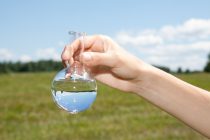Water filterscome in many forms, but they all rely on a limited number of technologies to remove the numerous contaminants typically found in water. Municipal water treatment systems employ several technologies to treat the water so that it’s fit for human consumption; however these disinfection methods come with a steep price tag on health. To protect drinking water from disease-causing organisms or pathogens, chloramines or chlorine is typically used to treat the water. Once either reacts with organic material, disinfection byproducts such as Trihalomethanes, Haloacetic Acids, Bromate and Chlorite are created which can pose health serious risks.
Some people who drink water containing total trihalomethanes in excess of the MCL over many years could experience liver, kidney, or central nervous system problems and increased risk of cancer. ~Environmental Protection Agency (EPA)
Understanding the types of technologies available to treat water for both biological and chemical contaminants will make it easier for you review the pros and cons of each. You can achieve clean, purified water by installing the appropriate filtration system that removes the toxins of concern from your water.
Here are a few pointers to help narrow down your search:
- Some filters combine the power of several technologies, while others work with one type of technology.
- To verify if a filter removes a certain contaminant, check whether it’s certified for that contaminant by a reputable agency such as NSFor the California Department of Public Health.
- Filters labeled “NSF” may be certified to remove toxins from water but these certifications aren’t all created equal. A filter may be certified to remove a specific contaminant, or in some cases, certification might be for improving water taste; be sure to read the fine print.
Seven Water Filtration System Basics
1) Activated Carbon/Carbon Filters
These vary in effectiveness, but generally carbonfilters remove contaminants such as lead, mercury, asbestos, and several other volatile organic compounds (VOC’s). Activated carbon chemically bonds with contaminants and removes them from the water – but it also has its limitations. These do not remove inorganic compounds such as fluoride. Additionally, depending on the NSF certification, some are effective at removing chlorine whereas others only remove chlorine taste and odor. Here are the two most common:
Carbon Block
These filters have a larger surface area than that of granulated activated carbon fiber which makes them more effective. This type of filter is made by heating activated carbon into blocks. Keep in mind though, that the speed at which water flows through the filter also determines how effectively filtered it is.
Granulated Activated Carbon
Carbon block filters work better than this type of filter. Granulated Activated Carbon contains tiny grains of activated carbon and they have a small surface area. Their performance is also affected by how fast water flows through them.
2) UV (ultraviolet)
Ultraviolet light can be used to kill certain microorganisms and bacteria; however, this process can notremove chemical pollutants.
3) Distillation
This type of filter uses heat to vaporize water and then the steam is condensed back to water. A large number of bacteria are removed this way, as well as chemicals and viruses. Distillation does not remove volatile organic chemicals (VOC’s), chlorine or trihalomethanes.
4) Mechanical Filters
These work like ceramic filters by removing solid contaminants. In order to clean the water more effectively, they are used in combination with other types of filters.
5) Reverse Osmosis
This can be effective at removing contaminants such as arsenic, fluoride, nitrates, hexavalent chromium and many other contaminants. In order to filter the contaminants, water is pushed through a semi-permeable membrane where particles larger than water molecules are blocked out.
6) Deionization
In case you’d prefer a more complex form of filtration, deionization removes electrically charged molecules and iron salts through an ion exchange process. Microorganisms and non-ionic compounds (ie: many VOC’s or trihalomethanes) can not be removed through an ion exchange process.
7) Ozone
According to the EPA, Bromate occurs when bromide in the water reacts with the disinfectant, ozone. It is great at killing bacteria and additional microorganisms, but works best when paired with other filtration methods as it is not effective at removing chemical contaminants.
Which System to Choose
When filtering drinking water for your home, you’re basically trying to remove a host of contaminants including microbial forms such as bacteria, parasites and algae, or inorganic contaminants such as copper, brass, aluminum, iron, etc. Untreated water contains a large number of potentially harmful organisms and compounds, all of which require advanced filters to remove.
POU (Point-of-Use)- These types of filtration devices introduce water at a single water connection (ie: kitchen sink) and include under-counter (ie: Reverse Osmosis), countertop(ie: Filtration never before available in a pitcherand Berkey) or faucet mounted filters (ie: PUR or Aquasana shower filters).
POE (Point-of-Entry)– These are installed at the main water line where water enters the home. They are also referred to as Whole House Water Filtersbecause they provide filtered water to all sinks, baths, showers, dishwashers, refrigerators, washing machines and toilets – basically, the entire house (ie: Rhino whole house water filter).
No single filter can remove all undesirables from your drinking water but using a filter lowers the risk of infection or long-term exposure to chemical contaminants. In order to get healthy water for your home, you may need to combine two or more filtration systems. Be sure you understand what the filter removes and test your water (if necessary) before purchasing the appropriate filter for optimal health.
Don’t Forget … Change Your Filters!
No filter will give you consistently good performance over the long term unless it receives regular maintenance. As contaminants build up, a filter can not only become less effective, but actually can make your water worse by starting to release harmful bacteria or chemicals back into your filtered water.


